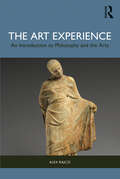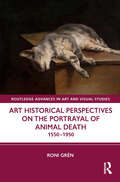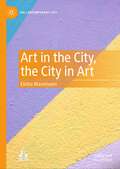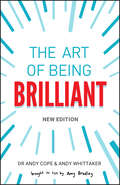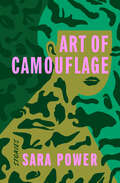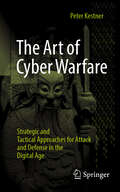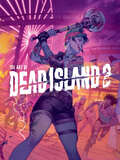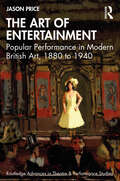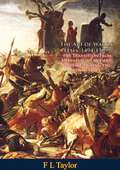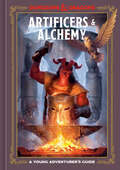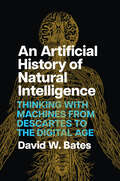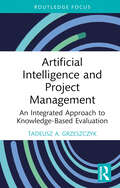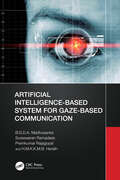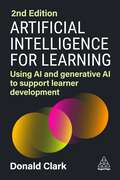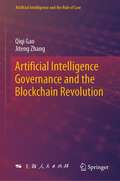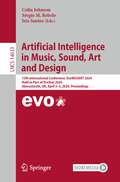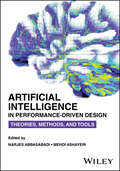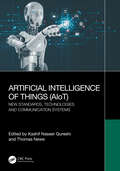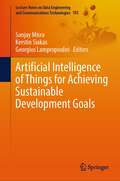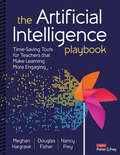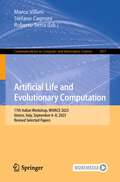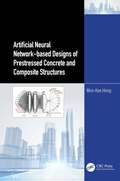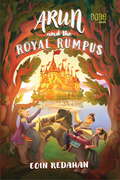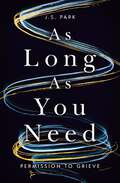- Table View
- List View
The Art Experience: An Introduction to Philosophy and the Arts
by Alex RajcziThe Art Experience: An Introduction to Philosophy and the Arts takes readers on an engaging and accessible journey that explores a series of fundamental questions about the nature of art and aesthetic value. The book’s 12 chapters explore three questions: What makes something a work of art? How should we experience art to get the most out of it? Once we understand art, how should we evaluate whether it is good or bad? Philosophical theory is illustrated with concrete examples: the paintings of Frida Kahlo, the music of Johann Sebastian Bach, the masks of the Nso people, and many others. Classic questions are balanced with cutting-edge challenges, such as Linda Nochlin’s work on the exclusion of women from the artistic canon.The Art Experience presupposes no prior knowledge of philosophy or art, and it will be of interest to any reader seeking an accessible and engaging introduction to this field. Along the way, readers learn how philosophical theories can affect our real-world experiences with painting, music, theater, and many other art forms.Key Features Accessible for any college student: assumes no knowledge of philosophy, art theory, or any artistic medium Organizes topics conceptually, rather than historically, allowing students to more easily grasp the core issues themselves rather than tracing their historical evolution Offers readers a large number of contemporary examples and a consistent focus on the way theory can affect people’s real-world experiences with art Explores questions about bias – for example, whether the artistic canon has excluded some groups unfairly and whether definitions of art are Western-biased
Art Historical Perspectives on the Portrayal of Animal Death: 1550–1950 (Routledge Advances in Art and Visual Studies)
by Roni GrénThis study concentrates on the discourses around animal death in arts and the ways they changed over time.Chapter topics span from religious symbolism to natural history cabinets, from hunting laws to animal rights, from economic history to formalist views on art. In other words, the book asks why artists have represented animal death in visual culture, maintaining that the practice has, through the whole era, been a crucial part of the understanding of our relation to the world and our identity as humans. This is the first truly integrative book-length examination of the depiction of dead animals in Western art.The book will be of interest to scholars working in art history, animal studies, and cultural history.
Art in the City, the City in Art (The Contemporary City)
by Elisha MasemannThis Book examines an interplay between discourses on the city that stress the need for rational-functional order and art’s imaginative deviations from the topdown structures of urban life. Moving between theory and praxis, the book situates the city as both a concept and physical construct through which lives and possibilities are shaped or defined. In response, certain modalities of art create spontaneous, non-rational and playful interludes that risk escape from the urban apparatus and a hyper-valorisation of rational order. A three-part framework is used to discuss this push-pull dynamic and to assess the strategies of shock, performative embodiment and intervention that emerged in post-war art movements and in contemporary performance and participatory art practices. The book examines how the disturbances introduced by artists throw the city construct into sharp relief, making it visible and activating momentary encounters where new modes of expression can emerge. This Book offers a new approach to interdisciplinary studies of art and urbanity. The book aims to delineate how the city—as concept and construct—is made visible through artistic practice and in turn challenged or interrogated. Students, researchers and professionals with an interest in the interaction between art and urban studies will discover a new perspective on how urban conditions and issues have been addressed through artistic practice. The book contributes to an evolving discourse in the urban humanities through an exposition of the city’s default construct that is made visible or reimagined through visual art in public spaces.
The Art of Being Brilliant: Transform Your Life By Doing What Works For You (The\art Of Being Brilliant Ser.)
by Andy Cope Andy WhittakerThe bestselling book on being brilliant, now in an all new edition In a world where there's a lot of talk about ‘living your best life’ and being your ‘best self’, The Art of Being Brilliant actually shows you how. From an author who is an expert in the science of happiness and positive psychology, this book is fun, non-patronising, and grounded in proven principles and practices. Since the publication of the first edition, this book has filled readers to the brim with happiness, positivity, wellbeing and, most importantly, success! This new edition has been updated to address modern issues such as screen time, social media, anxiety, resilience and relationships. Dr Andy Cope brings the knowhow, his writing partner Andy Whittaker provides the humour, and award-winning illustrator Amy Bradley brings this new edition to life. This book is crammed full of good advice, instructive case studies, inspiring quotes, and important questions to make you think about your work, relationships, and life. It shows you that success and happiness aren't about dramatic change—they're about finding out what really works for you and doing more of it! Gain inspiration through rich illustrations, inspiring quotes, and a truly fun read Rock up in life as your best self Learn to foster positivity and bring about success in every aspect of your life Find out how academic knowledge from psychology and beyond can propel you forward The Art of Being Brilliant is THE go-to book to help you feel brilliant.
Art of Camouflage
by Sara PowerA powerful debut about the lives of women and girls caught in the orbit of the military.Female recruits weathering toxic masculine environments. Military wives stretched thin across countless military moves, new cities and new selves. Military kids whose mercurial friendships flare and fade to the rhythm of their parent's career path. Throughout, this collection introduces us to characters who trespass beyond the boundaries of their own realities to discover who they are within someone else's narrative.Sara Power writes with insight and emotional precision about what it's like to be unmoored. Art of Camouflage is memorable at every turn, full of characters whose deepest motivations we recognize intrinsically as our own.
The Art of Cyber Warfare: Strategic and Tactical Approaches for Attack and Defense in the Digital Age
by Peter KestnerThe Art of Cyber Warfare explores the strategic and tactical approaches for offense and defense in the digital age. Drawing on historical conflicts from Sun Tzu to Carl von Clausewitz, the author illustrates that, despite changed conditions such as time, location, means, and resources – but not the laws of physics – it is possible to learn from past actions and reactions.The author aims to demonstrate in this book that, in reality, we have only transferred old methods into our current era but have forgotten to translate their reasons, effects, and the resulting lessons. For, as it has been for thousands of years, the reasons for human-created conflicts remain the same: wealth, fame, power, honor, or desire. Can we learn something from history for present and future (cyber) wars?
The Art of Dead Island 2
by Alex CalvinI Love HELL-A!This gory volume is dripping with insights showing just how the video game world of Dead Island 2 came to life!Featuring never before seen concept art on each of the Slayers, their gear and weapons, the ruined and iconic streets of post-outbreak Los Angeles, and the shambling hordes of dangerous undead that call them home! Also, this book showcases insights from the creators of the game, with captions and text written by Alex Calvin (Runescape: The First 20 Years).Dark Horse Books, Deep Silver, and Dambuster Studios proudly present: The Art of Dead Island 2!
The Art of Entertainment: Popular Performance in Modern British Art, 1880 to 1940 (ISSN)
by Jason PriceIn this book, theatre historian Jason Price looks at the relationships and exchanges that took place between high and low cultural forms in Britain from 1880 to 1940, focusing on the ways in which figures from popular entertainments, such as music hall serio-comics, clowns, and circus acrobats, came to feature in modern works of art.Readers with an interest in art, theatre, and the history of modern Britain will find Price’s approach, which sees major works of art used to illuminate the histories of once-famous entertainers and the wider social, political, and cultural landscape of this period, accessible and engaging. The book will bring to life for readers some of the most vivid works of modern British art and reveal how individuals historically overlooked due to their gender, sexuality, or race played a significant role in the shaping of British culture during this period of monumental social change.
The Art of War in Italy, 1494-1529: the Transition From Mediaeval to Modern Warfare During the Renaissance
by F L Taylor“The birth of 'New War' in ItalyIt is easy to consider the Renaissance as a time of enlightenment typified principally by the artistic and scientific genius of Leonardo da Vinci and his peers; but giant leaps forward are never confined to one aspect of society and the application of new ideas is always adapted to various purposes and the meeting of differing objectives. The creation of modern political science by Niccolo Machiavelli is a prime example of how new ways of thinking and doing impacted on the advancement and securing of power. These changes were inevitably accompanied by significant developments in making war more effectively, strategically and tactically-with corresponding advances in weaponry and other equipage. This excellent book considers these developments through the changes to traditional military strategy and the use of infantry, cavalry and artillery, in both open battle and fortification and siege-craft, at the turn of the sixteenth century.”-Print ed.
Artificers & Alchemy: A Young Adventurer's Guide (Dungeons & Dragons Young Adventurer's Guides)
by Jim Zub Stacy King Official Dungeons & Dragons LicensedAn immersive, one-of-a-kind guide to the wondrous magical items and creatures of Dungeons & Dragons, the world&’s most beloved tabletop role-playing gameFeaturing amazing illustrations and expert insights, Artificers & Alchemy explores peculiar phenomena, sentient weapons, guardian gear, and the artificers who create these enchanted objects. If you&’re eager to start your own D&D adventures, this guidebook provides the perfect starting point to creating worlds of fantasy and weaving an epic story all your own.
An Artificial History of Natural Intelligence: Thinking with Machines from Descartes to the Digital Age
by David W. BatesA new history of human intelligence that argues that humans know themselves by knowing their machines. We imagine that we are both in control of and controlled by our bodies—autonomous and yet automatic. This entanglement, according to David W. Bates, emerged in the seventeenth century when humans first built and compared themselves with machines. Reading varied thinkers from Descartes to Kant to Turing, Bates reveals how time and time again technological developments offered new ways to imagine how the body’s automaticity worked alongside the mind’s autonomy. Tracing these evolving lines of thought, An Artificial History of Natural Intelligence offers a new theorization of the human as a being that is dependent on technology and produces itself as an artificial automaton without a natural, outside origin.
Artificial Intelligence and Project Management: An Integrated Approach to Knowledge-Based Evaluation (ISSN)
by Tadeusz A. GrzeszczykAlthough some people had doubts about the usefulness of such solutions in the past, artificial intelligence (AI) plays a growing role in modern business. It can be expected that the interest in it will also lead to an increase in support for the planning, evaluation, and implementation of projects. In particular, the proper functioning of multifaceted evaluation methods has a crucial impact on the appropriate planning and execution of various projects, as well as the effective achievement of the organization’s goals. This book offers a presentation of the complex problems and challenges related to the development of AI in project management, proposes an integrated approach to knowledge-based evaluation, and indicates the possibilities of improving professional practical knowledge in this field.The unique contribution of this book is to draw attention to the possibilities resulting from conducting transdisciplinary research and drawing on the rich achievements in the field of research development on knowledge-based systems that can be used to holistically support the processes of planning, evaluation, and project management. The concept of the integrated approach to knowledge-based evaluation is presented and developed as a result of drawing inspiration mainly from the systems approach, generative AI, and selected mathematical models.Presented in a highly accessible manner, the book discusses mathematical tools in a simple way, which enables understanding of the content by readers across broad subject areas who may be not only participants in specialist training and university students but also practitioners, consultants, or evaluators. This book will be a valuable resource for academics and upper-level students, in particular, across project management-related fields, and of great interest to all those looking to understand the challenges and effectiveness of AI in business.
Artificial Intelligence-Based System for Gaze-Based Communication
by B.G.D.A. Madhusanka Sureswaran Ramadass Premkumar Rajagopal H.M.K.K.M.B. HerathThis book focuses on the artificial neural network-based system for gaze-based communication. It covers the feasible and practical collaboration of human–computer interaction (HCI) in which a user can intuitively express tasks using gaze-based communication. It will target the vast applications of gaze-based communication using computer vision, image processing, and artificial intelligence.Artificial Intelligence-Based System for Gaze-Based Communication introduces a novel method to recognize the implicit intention of users by using nonverbal communication in combination with computer vision technologies. A novel HCI framework is developed to enable implicit and intuitive gaze-based intention communications. This framework allows the users to intuitively express their intention using natural gaze cues. The book also focuses on robot caregiving technology, which can understand the user’s intentions using minimal interactions with the user. The authors examine gaze-based tracking applications for the assisted living of elderly people. The book examines detailed applications of eye-gaze communication for real-life problems. It also examines the advantages that most people can handle gaze-based communications because it requires very little effort, and most of the elderly and impaired can retain visual capability.This book is ideally designed for students, researchers, academicians, and professionals interested in exploring and implementing gaze-based communication strategies and those working in the field of computer vision and image processing.
Artificial Intelligence for Learning: Using AI and Generative AI to Support Learner Development
by Donald ClarkWith Artificial Intelligence (AI) creating huge opportunities for learning and employee development, how can learning professionals best implement the use of AI into their environment?Artificial Intelligence for Learning is the essential guide for learning professionals who want to understand how to use AI to improve all aspects of learning in organizations. This new edition debunks the myths and misconceptions around AI, discusses the learning theory behind generative AI and gives strategic and practical advice on how AI can be used.This book also includes specific guidance on how AI can provide learning support, chatbot functionality and content, as well as ideas on ethics and personalization. This book is necessary reading for all learning practitioners needing to understand AI and what it means in practice.
Artificial Intelligence Governance and the Blockchain Revolution (Artificial Intelligence and the Rule of Law)
by Qiqi Gao Jiteng ZhangThis is the first professional academic work in China to discuss artificial intelligence and blockchain together. Artificial intelligence is a productivity revolution, and its development has a significant and profound impact on global changes. However, at the same time, its development also brings a series of challenges to human society, such as privacy, security, and fairness issues. Therefore, the significance of blockchain is even more prominent. Blockchain is a revolution in production relations, which will propose important solutions to the challenges of privacy, security, and fairness that arise after the development of artificial intelligence. The book not only discusses the problems currently faced by the development of artificial intelligence, as well as the new opportunities and challenges that artificial intelligence brings to future global governance, but also explains the further development direction of the intelligent revolution from the perspective of blockchain.
Artificial Intelligence in Music, Sound, Art and Design: 13th International Conference, EvoMUSART 2024, Held as Part of EvoStar 2024, Aberystwyth, UK, April 3–5, 2024, Proceedings (Lecture Notes in Computer Science #14633)
by Colin Johnson Sérgio M. Rebelo Iria SantosThis book constitutes the refereed proceedings of the 13th International Conference on Artificial Intelligence in Music, Sound, Art and Design, EvoMUSART 2024, held as part of EvoStar 2024, in Aberystwyth, UK, April 3–5, 2024. The 17 full papers and 8 short papers presented in this book were carefully reviewed and selected from 55 submissions. The main purpose of this conference proceedings was to bring together practitioners who are using Artificial Intelligence techniques for artistic tasks, providing the opportunity to promote, present, and discuss ongoing work in the area.
Artificial Intelligence in Performance-Driven Design: Theories, Methods, and Tools
by Narjes Abbasabadi Mehdi AshayeriARTIFICIAL INTELLIGENCE IN PERFORMANCE-DRIVEN DESIGN A definitive, interdisciplinary reference to using artificial intelligence technology and data-driven methodologies for sustainable design Artificial Intelligence in Performance-Driven Design: Theories, Methods, and Tools explores the application of artificial intelligence (AI), specifically machine learning (ML), for performance modeling within the built environment. This work develops the theoretical foundations and methodological frameworks for utilizing AI/ML, with an emphasis on multi-scale modeling encompassing energy flows, environmental quality, and human systems. The book examines relevant practices, case studies, and computational tools that harness AI’s capabilities in modeling frameworks, enhancing the efficiency, accuracy, and integration of physics-based simulation, optimization, and automation processes. Furthermore, it highlights the integration of intelligent systems and digital twins throughout the lifecycle of the built environment, to enhance our understanding and management of these complex environments. This book also: Incorporates emerging technologies into practical ideas to improve performance analysis and sustainable design Presents data-driven methodologies and technologies that integrate into modeling and design platforms Shares valuable insights and tools for developing decarbonization pathways in urban buildings Includes contributions from expert researchers and educators across a range of related fields Artificial Intelligence in Performance-Driven Design is ideal for architects, engineers, planners, and researchers involved in sustainable design and the built environment. It’s also of interest to students of architecture, building science and technology, urban design and planning, environmental engineering, and computer science and engineering.
Artificial Intelligence of Things (AIoT): New Standards, Technologies and Communication Systems
by Kashif Naseer Qureshi Thomas NeweThis book is devoted to the new standards, technologies, and communication systems for Artificial Intelligence of Things (AIoT) networks. Smart and intelligent communication networks have gained significant attention due to the combination of AI and IoT networks to improve human and machine interfaces and enhance data processing and services. AIoT networks involve the collection of data from several devices and sensor nodes in the environment. AI can enhance these networks to make them faster, greener, smarter, and safer. Computer vision, language processing, and speech recognition are some examples of AIoT networks.Due to a large number of devices in today’s world, efficient and intelligent data processing is essential for problem-solving and decision-making. AI multiplies the value of these networks and promotes intelligence and learning capabilities, especially in homes, offices, and cities. However, several challenges have been observed in deploying AIoT networks, such as scalability, complexity, accuracy, and robustness. In addition, these networks are integrated with cloud, 5G networks, and blockchain methods for service provision. Many different solutions have been proposed to address issues related to machine and deep learning methods, ontology-based approaches, genetic algorithms, and fuzzy-based systems.This book aims to contribute to the state of the art and present current standards, technologies, and approaches for AIoT networks. This book focuses on existing solutions in AIoT network technologies, applications, services, standards, architectures, and security provisions. This book also introduces some new architectures and models for AIoT networks.
Artificial Intelligence of Things for Achieving Sustainable Development Goals (Lecture Notes on Data Engineering and Communications Technologies #192)
by Sanjay Misra Kerstin Siakas Georgios LampropoulosThis book covers various topics and trends regarding Artificial Intelligence (AI), Internet of Things (IoT), and their applications in society, industry, and environment for achieving Sustainable Development Goals (SDGs) suggested by the United Nations. Additionally, it discusses their advancements and fusion as well as the realization of Artificial Intelligence of Things (AIoT). The book aims to provide an overview and recent research into the fusion, integration, advancements, and impact of these technologies in the context of SDGs achievement. The topics include the applications of AI, IoT, big data, AI-based and IoT-based cloud computing, machine learning and deep learning techniques, and blockchain among others for achieving SDGs. It also presents findings and discussions on potential application domains, addresses open issues and challenges, offers solutions, and provides suggestions for future research for achieving SDGs. The chapters are clustered, according to particular SDGsor areas of focus, into: i) the realization of AIoT for SDGs, ii) the role of AIoT in achieving society and wellbeing-related SDGs, iii) the fulfillment of industrial sectors, infrastructure, and economy-related SDGs through AIoT, and iv) the use of AIoT to aid natural resources and environment-related SDGs. The book assists researchers, practitioners, professionals, and academicians of various scientific fields in exploring and better understanding these state-of-the-art technologies, their advancements, impact, future potentials and benefits, and their role in successfully achieving SDGs.The book:· Offers an in-depth overview of AIoT for achieving SDGs.· Presents the fusion of AI and IoT for bringing a significant change in everyday life and fulfilling SDGs.· Highlights innovative solutions and results of AIoT integration in several domains for achieving SDGs.· Showcases the influence of AIoT on promoting and improving sustainability in the context of SDGs.· Discusses the issues, benefits, solutions, and impact of AIoT in society, industry, and environment for achieving SDGs.
The Artificial Intelligence Playbook: Time-Saving Tools for Teachers that Make Learning More Engaging
by Meghan Hargrave Douglas Fisher Nancy FreyTime Saving AI Tools that Make Learning More Engaging Busy educators need tools that support their planning and provide them with more time with students. While Artificial Intelligence (AI) has emerged as a promising solution, it can only help if we’re willing to learn how to use it in ways that improve upon what we already do well. The Artificial Intelligence Playbook: Time Saving Tools that Make Learning More Engaging is here to empower teachers to explore AI’s potential and discover practical ways to implement it to enhance their planning and instruction. Two chapters and 6 "Educator Functions" guide teachers step-by-step through how to purposely use AI to: Compose Writing Prompts and Avoid Plagiarism Manage Content Foster Student Engagement Meet Students’ Instructional Needs Assess Student Learning Continue Lifelong Learning Though AI has the potential to reduce workload for educators, it will never replace teachers. Your connection with students is irreplaceable—and greatly impacts their learning. Consider AI a valuable tool that provides you with more time to build and sustain those vital relationships with students and that can assist them in learning at the very same time.
The Artificial Intelligence Playbook: Time-Saving Tools for Teachers that Make Learning More Engaging
by Meghan Hargrave Douglas Fisher Nancy FreyTime Saving AI Tools that Make Learning More Engaging Busy educators need tools that support their planning and provide them with more time with students. While Artificial Intelligence (AI) has emerged as a promising solution, it can only help if we’re willing to learn how to use it in ways that improve upon what we already do well. The Artificial Intelligence Playbook: Time Saving Tools that Make Learning More Engaging is here to empower teachers to explore AI’s potential and discover practical ways to implement it to enhance their planning and instruction. Two chapters and 6 "Educator Functions" guide teachers step-by-step through how to purposely use AI to: Compose Writing Prompts and Avoid Plagiarism Manage Content Foster Student Engagement Meet Students’ Instructional Needs Assess Student Learning Continue Lifelong Learning Though AI has the potential to reduce workload for educators, it will never replace teachers. Your connection with students is irreplaceable—and greatly impacts their learning. Consider AI a valuable tool that provides you with more time to build and sustain those vital relationships with students and that can assist them in learning at the very same time.
Artificial Life and Evolutionary Computation: 17th Italian Workshop, WIVACE 2023, Venice, Italy, September 6–8, 2023, Revised Selected Papers (Communications in Computer and Information Science #1977)
by Marco Villani Stefano Cagnoni Roberto SerraThis book constitutes the refereed post proceedings of the 17th Italian Workshop on Artificial Life and Evolutionary Computation, WIVACE 2023, held in Venice, Italy, during September 6–8, 2023.The 30 full papers included in this book were carefully reviewed and selected from 55 submissions. They were organized in topical sections as follows: Algorithms for complex systems, Biologically inspired models, Complex chemical systems, Adaptation and swarms, Learning, Medicine and Social systems.
Artificial Neural Network-based Designs of Prestressed Concrete and Composite Structures
by Won‐Kee HongThis book introduces artificial neural network (ANN)-based Lagrange optimization techniques for a structural design of prestressed concrete structures based on Eurocode 2, and composite structures based on American Institute of Steel Construction and American Concrete Institute standards. The book provides robust design charts for prestressed concrete structures, which are challenging to achieve using conventional design methods.Using ANN-based design charts, the holistic design of a post-tensioned beam is performed to optimize design targets (objective functions), while calculating 21 forward outputs, in arbitrary sequences, from 21 forward inputs. Applies the powerful tools of ANN to the optimization of prestressed concrete structures and composite structures including columns and beams Multi-objective optimizations (MOO) of prestressed concrete beams are performed using an ANN-based Lagrange algorithm Offers a Pareto frontier using an ANN-based MOO for composite beams and composite columns sustaining multi-biaxial loads Heavily illustrated in color and with diverse practical design examples in line with EC2, ACI, and ASTM codes The book offers optimal solutions for structural designers and researchers, enabling readers to construct design charts to minimize their own design targets under various design requirements based on any design code.
Arun and the Royal Rumpus
by Eoin RedahanWould you rather have the body of a tiger and the head of a boy, or the body of a boy and the head of a tiger?(Arun wants to know)When Arun, a twelve-year-old mischief maker hiding in the mountains, finds out about the plot to capture the crazy King Lalu, he vows to stop the vicious Vin and his thugs - by joining them. Armed only with a pea-shooter, Arun journeys through treacherous terrain, eerie forests, rushing rivers and even the sewers of Asamana with the help of the quick-tempered Krishma and scrappy Sai. Whether it's outsmarting the brutes, stealing a grouchy giant's keys, or trotting down a narrow mountain ledge on a one-eyed pony, Arun is ready to brave it all to save the king. Brimming with humour and adventure, this is not just one boy's gritty tale of friendship, family and mayhem- it's a downright royal rumpus!
As Long as You Need: Permission to Grieve
by J. S. Park"A heartfelt invitation for grieving readers...An excellent resource for those working their way through loss." —Publishers Weekly, Starred ReviewVeteran hospital chaplain to the sick, dying, and bereaved, J.S. Park offers you both the permission and the process for how to grieve and heal at your own pace.In As Long As You Need, J.S. offers an honest and unrushed engagement with grief, decoding four types of grieving—spiritual, mental, physical, and relational—and offering compassionate self-care and soul-care along the way.If you are struggling to process loss, pain, or grief from the last few years or the last few minutes, J.S. is an experienced and deeply empathetic listener and grief catcher who has held the pain and questions of thousands of patients. While social and cultural narratives about grief are dominated by "letting go, moving on, or turning the page" in his nearly decade of service as a chaplain at a major hospital with a designated level one trauma center J.S. understands firsthand how rushing or suppressing grief only adds a suffocating layer of pain on top of the original wound.From his unique window into the stories of the ill, injured, dying, and their families, J.S. offers you:Permission to dismantle all too common myths about grief and replace them with a guilt-free and unrushed approach to navigating your losses.Encouragement for how entering grief, rather than avoiding it, leads to a hard but meaningful holding of your loss.Empathy and hope if you are struggling with a crisis of faith in the midst of grief.Recognition that grief spans a wide narrative of loss: loss of future, faith, mental health, worth, autonomy, connection, and loved ones.Affirmation that your grief is your own. While the DNA of grief might be universal to the human condition, how you experience and process grief is unique to you. From the ER to deliveries to deathbeds across every sort of illness and injury imaginable, J.S. Park has provided meaningful counseling for people in all walks of life and death. Now, through his book he wants to assure you that, while everybody else might rush past your pain, grief is the voice that says, take as long as you need.
